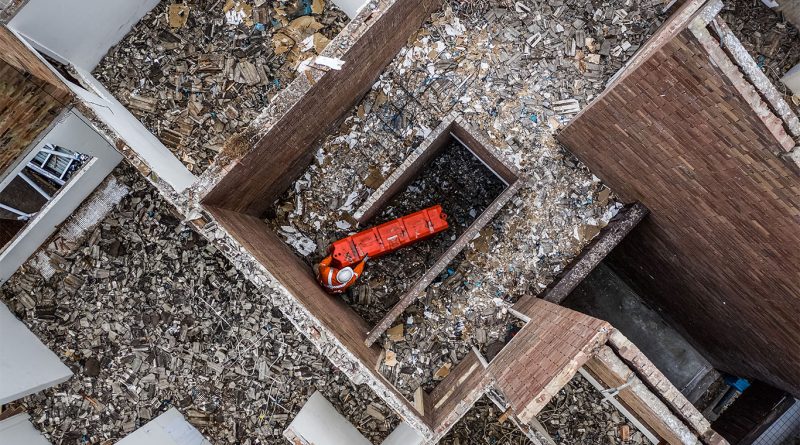8 practical tips for effective construction waste management
Construction waste is one of the most significant by-products of the building industry, contributing to over 60% of total UK waste. Effective construction waste management is not only a legal and environmental necessity but also a business imperative. A well-structured approach can cut costs, improve on-site safety, enhance brand reputation and reduce carbon footprint. Implementing a comprehensive strategy that includes planning, segregation, stakeholder engagement and performance monitoring is essential for sustainable construction.
What is a construction site waste management plan (SWMP)?
A SWMP is a structured document that outlines how waste will be handled throughout a construction project, from planning and design to completion. It includes forecasts of expected waste types and volumes, measures to reduce and recycle materials, procedures for on-site segregation and disposal, and documentation of waste carriers. Although not always legally required in the UK, many clients and local authorities expect one. A good SWMP helps meet legal obligations, reduces environmental impact and supports cost efficiency.
1. Forecasting & design integration
Waste planning must begin at the design and procurement stage. Forecasting the types and quantities of materials used helps avoid over-ordering and ensures the SWMP is based on realistic data. Strategic planning can identify opportunities to reduce waste before construction begins. Incorporating design features like standardised components, prefabricated materials and modular construction can significantly reduce offcuts, packaging and overages. Early engagement with suppliers and design teams ensures waste-conscious decisions are embedded into the project from the outset.
2. Adopt the waste hierarchy
The waste hierarchy of reduce, reuse and recycle is central to effective construction waste management. Reduction involves minimising waste generation through smart procurement and planning. Reuse focuses on salvaging materials on-site or between projects, such as timber, bricks or fittings. Recycling is the final option, ensuring materials like concrete, plastics or metals are diverted from landfill. Projects that prioritise higher tiers of the hierarchy often see lower disposal costs, reduced environmental impact and improved stakeholder perception.
3. Implement on-site segregation & handling
Segregating waste on-site makes recycling more efficient and compliant with regulations. Provide clearly labelled skips or bins for common waste streams such as concrete, timber, metal, plastic and packaging. Prevent cross-contamination by training workers and enforcing consistent practices. Protect stored materials to avoid damage that leads to unnecessary waste, especially for moisture-sensitive materials. Effective segregation supports better recycling rates and can reduce landfill tax liabilities. It also makes it easier to track and report waste management performance against key metrics.
4. Choose materials & suppliers wisely
Material selection and procurement decisions have long-term implications for waste. Specify materials with minimal or recyclable packaging. Source locally to reduce transport waste. Opt for reusable or recycled materials where possible. Working with suppliers to deliver materials just-in-time limits on-site storage and reduces risks of damage or theft. Some suppliers offer take-back schemes for packaging or surplus materials. Sustainable procurement not only lowers environmental impact but also supports achieving green building certifications on larger projects.
5. Use licensed waste carriers & comply with regulation
In the UK, construction waste must be handled by licensed carriers and proper documentation must be kept. This includes waste transfer notes, hazardous waste consignment notes and evidence of correct disposal or recycling. Companies must also meet Duty of Care obligations to ensure waste is handled legally and safely. Using accredited contractors helps avoid liability and ensures compliance with Environment Agency regulations. Auditing carriers and disposal sites is a best practice that protects reputation and reduces risk of enforcement action.
6. Engage the whole team & stakeholders
Effective waste management involves everyone on the project, from architects to labourers. Include waste awareness in site inductions and toolbox talks. Set clear targets for waste reduction and track progress visibly on site. Engage subcontractors and suppliers with incentives or performance indicators related to waste. A culture of accountability and communication improves compliance and makes the SWMP a shared responsibility. Client support is also crucial, especially when specifying reused or recycled materials or allowing for deconstruction methods.
7. Monitor, measure & review performance
Track actual waste generation versus forecasts in your SWMP. Use data to identify trends, inefficiencies and opportunities. Key metrics include total waste generated, reuse and recycling rates and cost per tonne of disposal. Periodic reviews during the project allow for mid-course corrections. At project close, a full audit of waste performance supports lessons learned for future jobs. Monitoring ensures regulatory compliance, provides transparency to clients and helps improve environmental and financial outcomes over time.
8. Seek innovation & embrace circularity
The shift toward a circular economy is gaining momentum in construction. New technologies such as Building Information Modelling (BIM) can model material flows and reduce waste at design stage. Deconstruction and salvage are replacing demolition in some sectors, enabling valuable materials to re-enter supply chains. Some firms are now building with reclaimed components sourced from online platforms or recycling cooperatives. Exploring innovative disposal and recycling methods such as crushing concrete for reuse or partnering with recyclers for complex materials positions firms ahead of regulatory and market trends.
Building toward a sustainable future
Construction waste management is no longer optional. It is essential to future-proof operations in a cost-effective, compliant and environmentally responsible way. With rising regulatory scrutiny and growing pressure for sustainable building practices, having a clear plan for managing waste from the outset is critical. By implementing these eight practical tips, companies can improve performance, reduce waste, and align their operations with the construction industry’s shift toward circularity and long-term resilience.
